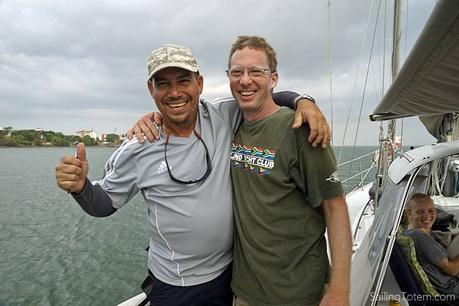
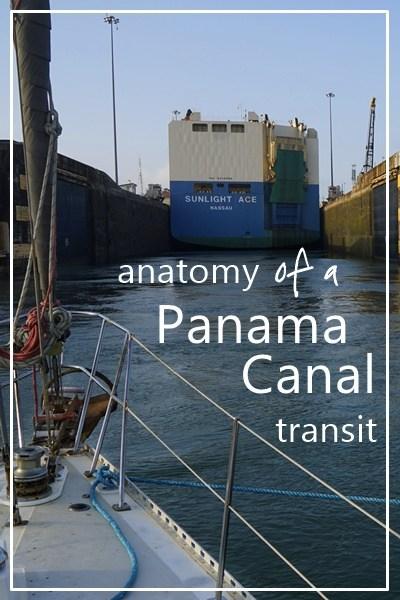
“Cristobal Signal Station, this is sailing vessel Totem.” After weeks of anticipation and planning, the VHF call to inform the port entry coordinator of Totem’s location marks the start of our canal transit.
Pre-transit planning
This process began with research a few months before. Approach varies depending on whether you do it yourself or hire an agent. Despite a bias to DIY, we chose the latter to have an advocate for getting through in a timely fashion and avoid tramping around Colon (unsafe in the best of times, worse with the rioting this month).
The agent will handle:
- the canal officialdom runaround
- organize lines (4 x 125’) and fenders and line handlers if needed (for a fee)
- cover your $900 “buffer” fee with the Panama Canal Authority (ACP)
- advocate for your desired transit date
- assist with outbound clearance
Colon has a dismal reputation for personal safety and erupted in riots in March, so it was peace of mind that our agent did the leg work there. He also found us early transit dates when arriving boats were being assigned two to three weeks wait period.

Jamie coaches our line handlers before transit. Yes, the Flats is quite a charming anchorage…
Want to DIY? No problem, by all accounts. Good cruiser descriptions for their DIY transit to be found at Gone with the Wynns, White Spot Pirates, and ImpetuousToo.
Waiting to transit
A transit date is only assigned after your official measurement is complete and all canal fees are paid. This interval can take a few days in low season or a few weeks at peak. Waiting in Colon means either paying steep rates at Shelter Bay Marina (owning the monopoly!) or anchoring out where you 1) must not leave the boat unattended for security reasons, and 2) have no place to leave the dinghy, so it’s drop-offs / pickups only.
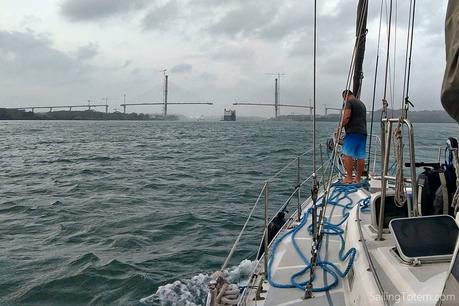
Motoring up to the first locks on departure day
If your assigned transit date is too long to wait around Colon, there are two options. First, pay to fast track. We were quoted about $3,000 in addition to other canal fees to request an expedited transit from the ACP. Well that was nice to know! Alternatively, do a day sail east to historic Portobelo or go overnight to Guna Yala (San Blas). Getting to either can involve bashing during peak tradewinds; watch conditions.
Go time!
Six humans is the minimum crew during transit: the captain, four line handlers, and an ACP advisor. Mairen and Siobhan were rejected as line handlers (on the unfair basis of their gender, as far as I could tell, but it’s not our call). They’d have done fine, but it was a bonus to have two friends aboard helping fill the role.
Cruising boats do what’s called a handline transit: this means the lines between ship and shore are moved by human handlers. Commercial ships (or fancypants boats measuring 125’ and more) get pulled through the locks by cables attached to locomotives.
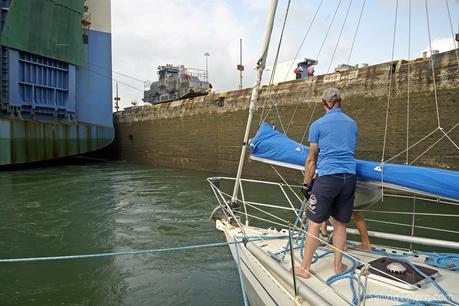
Shoreside locomotive with cables to our Ro-Ro lock buddy, Sunshine Ace
Handline transit vessels have four possible configurations to pass through the locks. When your boat is measured, you can specify top two preferences with the admeasurer. Descriptions to prepare for locking through in different configurations is thoroughly detailed in the Mad About Panama ebook.
Transit begins by meeting your advisor at The Flats, an anchorage 2.5 miles from the first Caribbean-side lock. Totem was assigned a one-day transit, so we anchored overnight as the advisor was due to arrive before sunrise. Andrew and Tristan From Utopia II joined us as linehandlers (and entertainment!). When two other boats anchored nearby, we suspected that our raft partners had arrived. Just before dawn, an ACP vessel maneuvered in to deliver an advisor to each anchored boat.
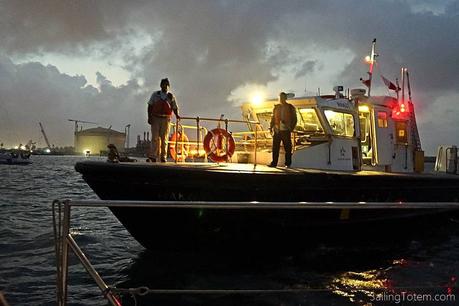
And advisor is delivered to Totem at dawn
The canal is roughly 37 miles long, most of which is the waterway of Lake Gatun and canal cuts between the trios of locks at each end. Entering from the Caribbean side, three sequential chambers of the Gatun locks lift vessels up around 90 feet. On the Pacific side, there’s a brief motor across Lake Miraflores between the inland lock (Pedro Miguel) and the last two chambers (in front of the Miraflores visitor center) where boats are lowered back down.
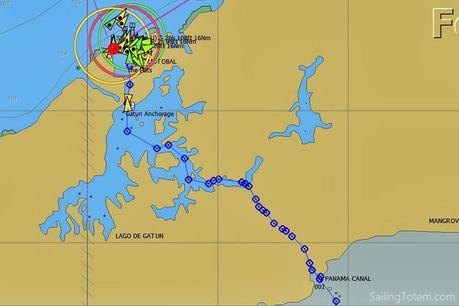
Canal path screenshot on OpenCPN
With our advisor, Roy, on board things began to happen quickly. We were directed to create a raft with Totem in the middle. Roy dryly commented, “perfect, now we have big fenders to protect us.” We like Roy! The boats remained rafted through the first three locks, then separated to cross Lake Gatun, rafting up again to descend the last three locks.
Entering the locks
As the center boat, Totem was responsible for primary propulsion of the raft and Roy was the lead advisor to direct all three boats. It also meant an easier trip for Totem’s line handlers. Once the raft was formed by securing bow, stern, and spring lines, our line-handlers became passengers.
Most cruising boats share the chamber with a commercial vessel. When locking up (towards the higher water in Lake Gatun), commercial boats enter first. Our “buddy boat” for the first series of locks was the 650’ ro-ro (roll-on, roll-off car carrier), Sunlight Ace.
As the raft drives slowly into the open lock, four ACP handlers – two on each side of the lock walls – throw a small, weighted monkey’s fist with messenger line attached down to the two boats on the outside of the raft. Line handlers on these boats tie the messenger lines to loops on to corresponding bow and stern lines. This does require that the line-handler know how to tie a knot! Our expectation was this was fast and furious, but it happens slowly. This is not the tricky part.
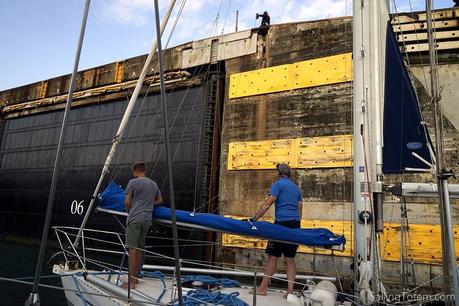
It’s an intimidating toss for the weighted line from a shoreside handler
When messenger line and your line are joined, the shoreside line-handlers pull your lines up the lock walls and secure the loop on large bollards (big ship cleats). When boats are secure, the riveted steel plates on the massive lock doors begin to close.
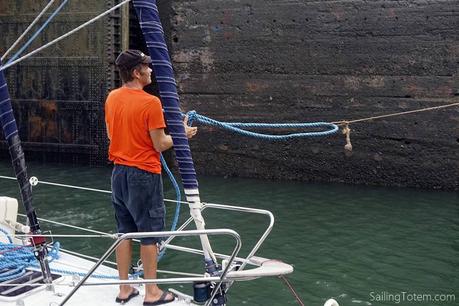
Sending lines back up to shore
What happens in the locks?
When the lock doors close and water level begins to change, the line handlers must tension (or loosen) the lines per advisor instructions. It sounds easy, right? But a line handler thinking about capturing the scene on the GoPro they have stuffed in a pocket may not respond when necessary. A cleat that is cluttered by junk on deck will make the line handler’s job unnecessarily difficult. A language barrier between handler and/or skipper and/or and advisor can cause problems from missed or delayed communications. A side-boat advisor distracted by cell phone because primary advisor is in charge is dangerous too.
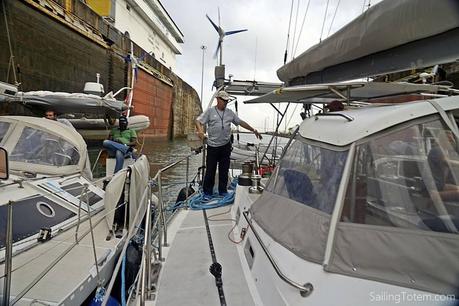
Roy advises all three boats from the center of the raft
Once the change starts, it is critical to keep pace tightening or easing the lines to shore as directed. Something like 55 million gallons flow through in 10 minutes and the water movement is intense. Salt and fresh water don’t like to mix, so when they flood together, lighter fresh water rushes over the salt water create currents on horizontal and vertical planes. If spider-leg lines holding your three-boat raft in place are not properly handled the raft can begin to spin, which is when bad things happen to boat.
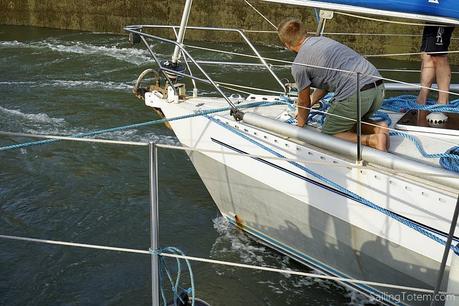
Handlers manage lines during intense turbulence in the chamber
Dry descriptions don’t convey how heated action can be inside the chamber. Turbulent water can damage boats and humans. When locking “up” to Lake Gatun, lines had to be tightened as the raft floated up to meet the top of each lock, shrinking the distance from boat to bollard. Locking “down” meant loosening lines. If not closely watched, the lines really load up. One of the boats next to us was sloppy with easing the lines when the raft started to shift. The crew realized and scrambled to secure the line that was pulling from them, and twice, nearly caught hand/fingers in the process. So much better to just pay attention!
Exiting the locks
When a massive ship just in front of you spins up the props to move out of the lock, there is a lot of wash. Totem’s engine in forward with moderate RPMs to hold station against four knots of current. All hands must pay close attention to advisor direction to keep the boats centered and pointing straight.
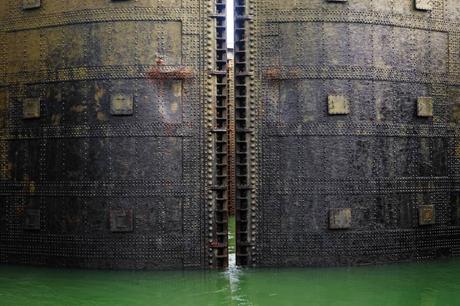
Massive steel lock gates in the canal. Does this make it look gentle? It’s not!
Once turbulence subsides, the raft slowly motors forward. If another lock is immediately adjacent (this happens three times), the shoreside handlers walked the raft like they were a trio of dogs on a leash. If there’s not another lock immediately ahead, shoreside handlers will remove lines from bollards and toss them into the water for the boats to pull in.
When dismantling the raft for Lake Gatun and at the exit, the connected boats first motor ahead a safe distance to be clear before separating under the advisor’s direction.
Lake Gatun
By the time we reached Lake Gatun, it felt like the day should be half over – but it was barely 10 o’clock in the morning! Time to hydrate and pass the snacks.
If assigned a two-day transit, you spend the night tied to a large buoy just outside the channel. Lake Gatun is an artificial lake full of tree-stumps and other anchor-eating debris, so it’s mooring only! We initially hoped for this overnight stay, to watch for crocs and listen for howler monkeys. In hindsight the one-day transit was nice to get it done, though long at 11 hours. Thanks to our friend Tammy for this photo of their Gatun mooring!

From here it’s a motorboat ride through history on the big-ship highway to Pedro Miguel locks on the far side. Mad About Panama’s ebook details it all, from how to spot Noriega’s jail to the crane called Titan that was built by Hitler’s Germany and claimed by the US as a war prize…it’s still used to service lock doors.
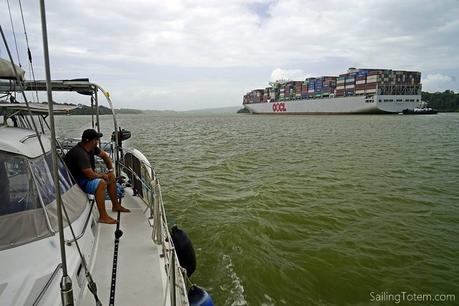
Andrew keeping an eye on traffic
Differences in the last locks
Locking down the three chambers reverses a few aspects of locking up – besides the obvious descent. Cruising boats enter first, with the commercial vessel behind. Boats float at the same level as shoreside handlers, so Monkey’s fists are tossed across instead of dropped down, a less intimidating prospect for the weighted line.
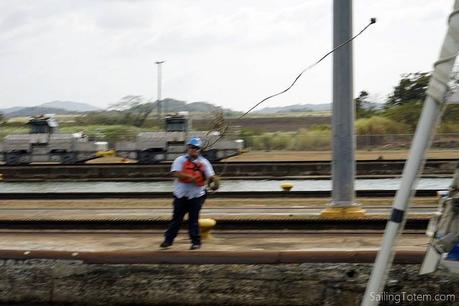
Lousy picture – you get the idea!
Current effects were different: again, it was essential to pay close attention to the advisors direction and expect that his instructions may not feel intuitive. Our return to the Pacific (a journey which the canal makes mostly by going south, and a little east!) was a relief, celebrated with the
Takeaways for a safe transit
Notes on our transit, reflections over the last two weeks, have gelled some perspective on our transit: what worked, what could have been done better.
Foremost, all advisors are not created alike. Roy was excellent, and helped us have a problem-free trip. Advisors adjacent to Totem were more attentive to their smartphones than the line handlers. This caused a few exciting moments – all ended well, anyway.
The advisor isn’t the captain—you’re responsible for boat and crew!—but our number one takeaway to transit safely is that it’s essential to work tightly with the advisor. They understand the lock conditions: some instructions may seem odd, like directions to turn the boat to point towards a lock wall, but it’s for a reason. There could be a four knot current deflected by the wall, and their direction is to prevent bad things from happening.
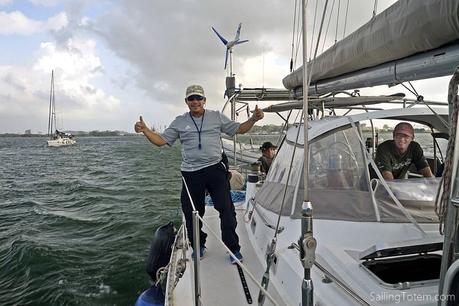
Our advisor, Roy, was all that and a bag of chips. We scored with this great guy on board!
The advisor is assigned; you don’t have control over that. Here’s what you can control and do to prepare.
- Clear decks. The area around bow and stern cleats must be as clear as possible. We moved stern rail mounted outboard to rest on deck near Totem’s mast to free up space near the stern cleats.
- You’re either a line handler or you’re not. If you want to take photos or text or adjust your GoPro or message Facebook friends or, or, or, when in the locks, then you are not a line handler.
- Fair leads! You know your boat: if the bow line has to pass through the bow pulpit for a clear path to the cleat, then have it run that way at the start. Re-leading in the moment takes time you may not have if currents start spinning the raft.
- Stern lines: Jamie felt these took the most load: a strategy to consider is running them to a cockpit winch with the stern cleat as a guide. This gives far better control when easing a loaded line and more muscle to tension when required.
- Repeat the instruction given by the advisor. This makes the advisor’s job easier by confirming you heard and are responding to the action called for. It may serve to clarify the advisor’s intentions when issuing rapid instructions.
- Mitigating an un-engaged advisor. If the lead advisor is distracted or communication is poor (and even if they’re not), proactively talk through maneuvers before they need to happen. We felt the boats rafted to us struggled a couple of times due to less attentive advisors.
- PAY ATTENTION! The lead advisor (who is not necessarily on your boat) may call for rapid engine and or steering changes. One of the boats rafted to us was… less attentive. It created a couple of fire drills and added to our burden to prevent the raft from spinning.

Totem and her fenders I mean lock mates: a nearly matched set of Ovnis.
Resources for planning
- Start at Noonsite: succinct, solid orientation for the process.
- Ready for details? They’re all in Mad About Panama’s website and very useful $1.99 ebook. If you read just one guide to prepare, this should be it.
- Also helpful is The Panama Cruising Guide (Bauhaus) but it’s very expensive if you only want canal info. Invaluable for Guna Yala, however, a good all-around cruising guide for Panama.
- To appreciate the magnitude of this awesome feat of human labor, read David McCullough’s The Path Between the Seas
- In addition to reading, first-timers can prepare by volunteering to line handle for another cruiser in advance of their own transit: a great way to pay it forward and internalize the process before going in your own boat. Listen on the morning VHF nets (details on Noonsite)
Totem is now northbound from Panama, lingering off Costa Rica for a better window to get across the Papagayos. We’ll cross our circumnavigation track in Zihuatanejo, Mexico, in the next few weeks. If you’ll be in the neighborhood, let us know!

